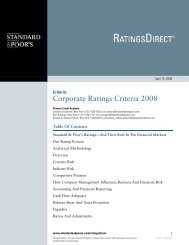European Infrastructure Finance Yearbook - Investing In Bonds ...
European Infrastructure Finance Yearbook - Investing In Bonds ...
European Infrastructure Finance Yearbook - Investing In Bonds ...
You also want an ePaper? Increase the reach of your titles
YUMPU automatically turns print PDFs into web optimized ePapers that Google loves.
Publication Date:<br />
Nov. 2, 2007<br />
Primary Credit Analyst:<br />
Lidia Polakovic,<br />
London,<br />
(44) 20-7176-3985<br />
Secondary Credit Analysts:<br />
Karin Erlander,<br />
London,<br />
(44) 20-7176-3584<br />
Michael Wilkins,<br />
London,<br />
(44) 20-7176-3528<br />
SWEDEN MOVES CLOSER TO PPP MODEL AS ALTERNATIVE<br />
FINANCING FOR INFRASTRUCTURE ASSETS<br />
Sweden is making significant steps in<br />
developing a model for public-private<br />
partnerships (PPPs) to provide an alternative<br />
means of financing public infrastructure. On June<br />
18, 2007, a joint working group commissioned by<br />
the Swedish government--made up of the public<br />
rail authority (Banverket), the public road<br />
authority (Vägverket), and the Swedish National<br />
Road and Transport Research <strong>In</strong>stitute (VTI)-published<br />
a proposal for a Swedish PPP model<br />
and identified a number of potential future<br />
PPP projects.<br />
Recently, the country’s public road and railway<br />
authorities announced the deferral of a substantial<br />
number of state-funded investments. A solution<br />
involving PPP financing could minimize future<br />
delays in necessary infrastructure developments.<br />
For private investors, the existence of a project<br />
pipeline detailing projects in terms of both<br />
number and size is important, given the relatively<br />
high costs associated with PPP bidding. It is also<br />
important for the public sector, to keep<br />
transaction costs low.<br />
For now, however, it is not clear if the PPP<br />
model will be selected and used on a larger scale,<br />
and, if so, how long implementation will take.<br />
Large <strong>In</strong>vestment Needed, But Grants Might<br />
Not Suffice<br />
Currently, transportation infrastructure<br />
investments are funded mainly through the state<br />
budget on a year-by-year basis. State budget<br />
grants for road investments for the 2006-2009<br />
period total about Swedish krona (SEK) 70 billion<br />
(SEK17 billion-SEK18 billion per year), while<br />
earmarked spending on rail for the period comes<br />
to about SEK52 billion (SEK11 billion-SEK14<br />
billion per year) (see table 1).<br />
While the need for investment in infrastructure,<br />
Table 1 - Major Rail Projects <strong>In</strong> State Budget<br />
Project <strong>In</strong>vestment (bil. SEK) Details<br />
Malmö city tunnel 9.5 (4.6 used) <strong>Finance</strong>d by the government, the municipality of<br />
Malmö, the county council of Skåne, and EU<br />
contributions<br />
Hallandsåsen railroad tunnel 7.5 N.A.<br />
Citybanan line in Stockholm 13.7 (1.0 used) SEK4 billion to be financed by Stockholm<br />
municipality and Stockholm county council<br />
Botniabanan railroad in northern Sweden<br />
SEK--Swedish krona. N.A.--Not available.<br />
13.2 (9.5 used) N.A.<br />
STANDARD & POOR’S EUROPEAN INFRASTRUCTURE FINANCE YEARBOOK<br />
PROJECT FINANCE/PUBLIC-PRIVATE PARTNERSHIPS<br />
mainly roads and rail, is evident in certain regions<br />
to develop economic growth, in other areas<br />
investment is needed to alleviate congestion. <strong>In</strong><br />
these cases, the approval of projects via the<br />
budget on a year-by-year basis could prove too<br />
slow to meet increasing demand. <strong>In</strong> addition,<br />
budgeted state contributions for the infrastructure<br />
sector have remained largely unchanged, failing to<br />
reflect cost increases. Recently, both the<br />
Vägverket and the Banverket announced<br />
significant investment reductions due to<br />
insufficient funding. As an example, total<br />
Vägverket investment grants for 2007 amount to<br />
SEK42.5 billion, unchanged from 2004, while<br />
construction costs have increased by 16% since<br />
2004. Consequently, the Vägverket has had to cut<br />
spending on projects by a similar amount.<br />
Although investments can be delayed on a shortterm<br />
basis, the Vägverket is concerned about the<br />
long-term effects on road quality and safety if this<br />
situation continues. The rail sector faces a similar<br />
situation, with capacity shortages in major cities<br />
and traffic disruptions. If investment spending<br />
remains unchanged, investments in infrastructure<br />
are likely to slow further.<br />
The current system, in certain cases, allows<br />
public authorities with access to budget funds to<br />
finance major projects by taking loans from the<br />
national debt office. Total debt issued by the<br />
national debt office to the Vägverket and the<br />
Banverket stood at SEK32.4 billion at year-end<br />
2006. <strong>In</strong> some cases the government (Kingdom of<br />
Sweden; AAA/Stable/A-1+) has guaranteed private<br />
debt, as in the case of the Öresund bridge<br />
between Sweden and Denmark. <strong>In</strong> rare cases,<br />
infrastructure investments are financed by charges<br />
paid by the user (for example the train link<br />
between Stockholm and Arlanda airport and the<br />
Svinesund bridge between Sweden and Norway).<br />
NOVEMBER 2007 ■ 129



